This blog is a preview of our State of Web3 Report. Sign up here to download your copy!
For artists, brands, and gamers, the metaverse is a living reality. Travis Scott’s Fortnite concert was attended by 27 million; the Vatican is opening an NFT art gallery; JP Morgan just signed a yearlong lease for a digital property.
This swift adoption is a testament to the metaverse’s current and future utility – and is reflected in virtual property pricing. From September 2019 through March 2022, blockchain-based virtual real estate prices grew by 879%. Real estate prices, meanwhile, grew by 39%.
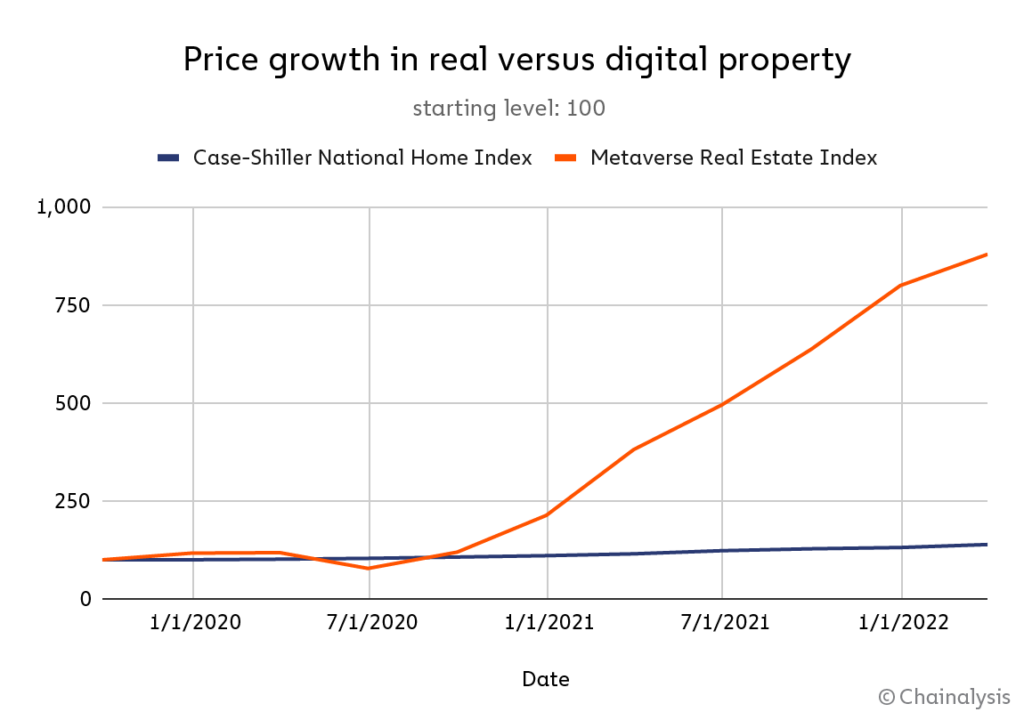 While this comparison is hardly apples-to-apples – the Case-Shiller index tracks physical single-family housing; the Metaverse index tracks digital parcels – it’s nonetheless surprising. In the period studied, virtual real estate prices outpaced physical real estate by 532%. Why might that be?
While this comparison is hardly apples-to-apples – the Case-Shiller index tracks physical single-family housing; the Metaverse index tracks digital parcels – it’s nonetheless surprising. In the period studied, virtual real estate prices outpaced physical real estate by 532%. Why might that be?
Let’s dig in.
In this article:
- What’s the utility of metaverse property?
- Where’s the most affordable metaverse housing?
- How long are users holding on to virtual real estate?
- What external factors will determine the long-term value of virtual real estate?
The utility of metaverse property
Blockchain-based virtual real estate (VRE) offers both present-day and prospective benefits to the people who own it. Let’s take a look at both types of amenities.
Present-day utilities
- Embedded videos, images, NFTs, and objects with interactivity
- In-game single-player and multiplayer activities
- Play-and-earn integrations
- Screen-sharing and twitter spaces-like town hall functionalities
- Access to private events and NFT-gated communities
This last feature – access to private events and exclusive communities – has been a big driver of non-fungible token (NFT) demand to date, and it looks to be translating into sales of virtual real estate. Bored Ape Yacht Club, for example, has always bundled its NFTs with entertainment, socialization and digital community. and they’ve since parlayed that appeal into a $310 million metaverse land sale.
Prospective utilities of virtual real estate
- Price appreciation
- Renting and leasing
- Free airdrops of future NFTs
- Future AR/VR integrations and functionalities
Not all metaverse projects promise every one of these utilities — and there may be some we’re missing — but most offer several from each category.
Where’s the most affordable metaverse housing?
The biggest differences in virtual land prices seem to be between blockchains, not within them. Relative to virtual land on Ethereum, virtual land on Solana has much lower entry-level pricing.
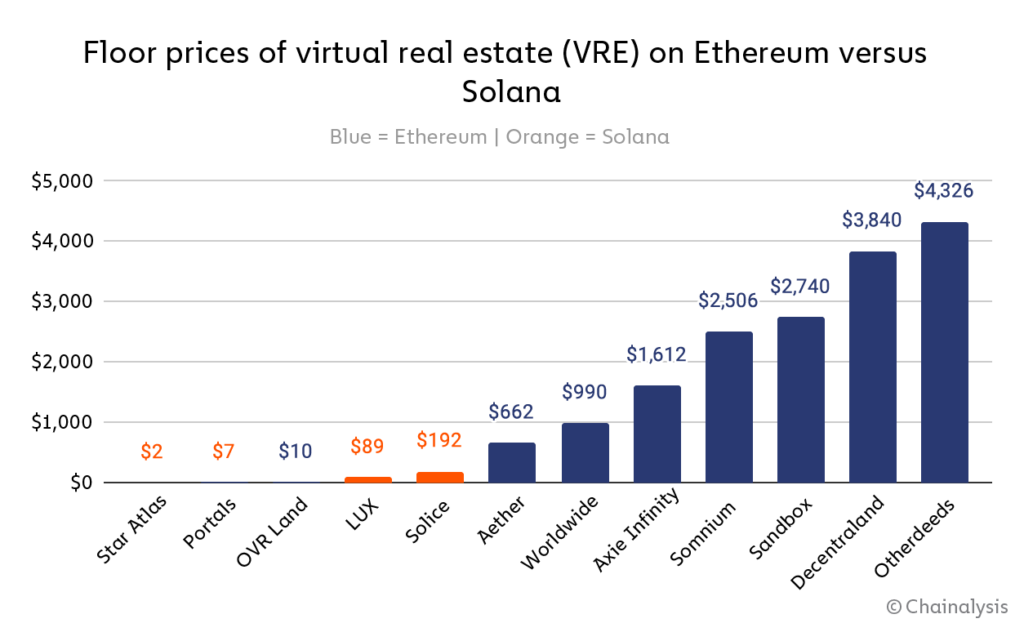
Solana gas fees average $0.00025, a fraction of Ethereum’s $5 to $50. This may make “affordable virtual housing” more practical for holders and developers on Solana.
That being said, almost every Ethereum-based virtual world listed above has recently integrated with Polygon, an Ethereum sidechain that competes with Solana on both cost and speed. So while this gap may be explained in part by transaction fees, it could soon (or already) be explained by differences in popularity or monetization strategy.
How long are users holding their virtual real estate?
The average duration of users’ land holdings varies widely. Across the 11 Ethereum-based metaverses for which we have data about holdings, most signs point to speculative activity.
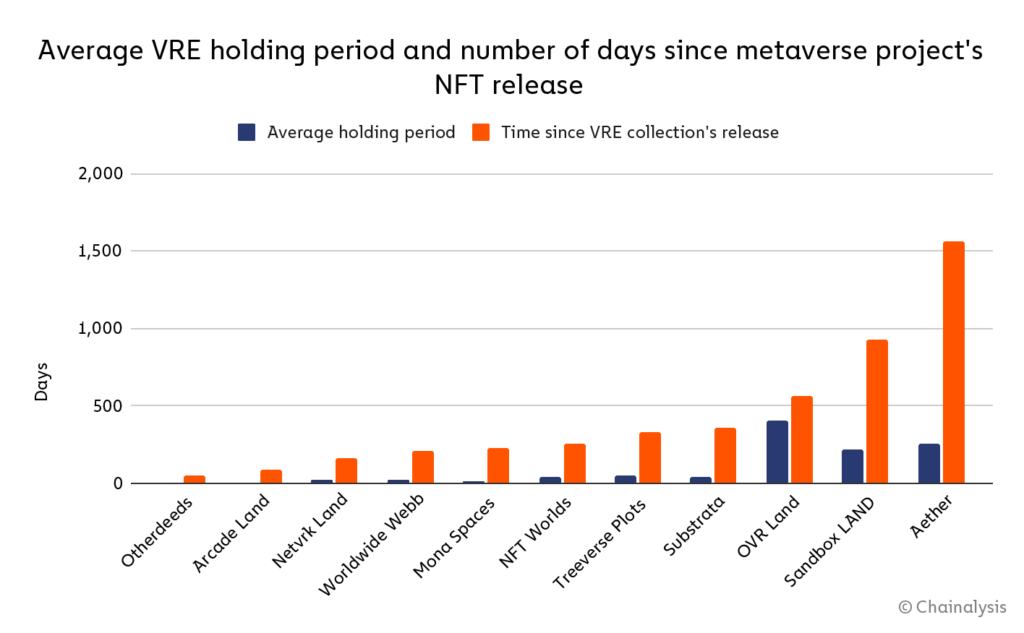
In 10 out of 11 of the projects we study, users have held their VRE NFTs for less than 25% of the time the NFT collection has been live. In 6 out of 11, they’ve held it for less than 15%. In other words, VRE purchases in most of the above projects would be best characterized as “flipping.”
The biggest exception is OVR Land. OVR Land has the longest holders for three likely reasons: the land is abundant, cheap, and takes time to develop. There are more than 1.6 trillion OVR lands, each one costs just $10 to $50, and when you buy one, what you’re actually buying is the opportunity to overlay augmented reality (AR) experiences on top of real-world geography.
For example, here are two parcels of OVR land listed for sale in France.
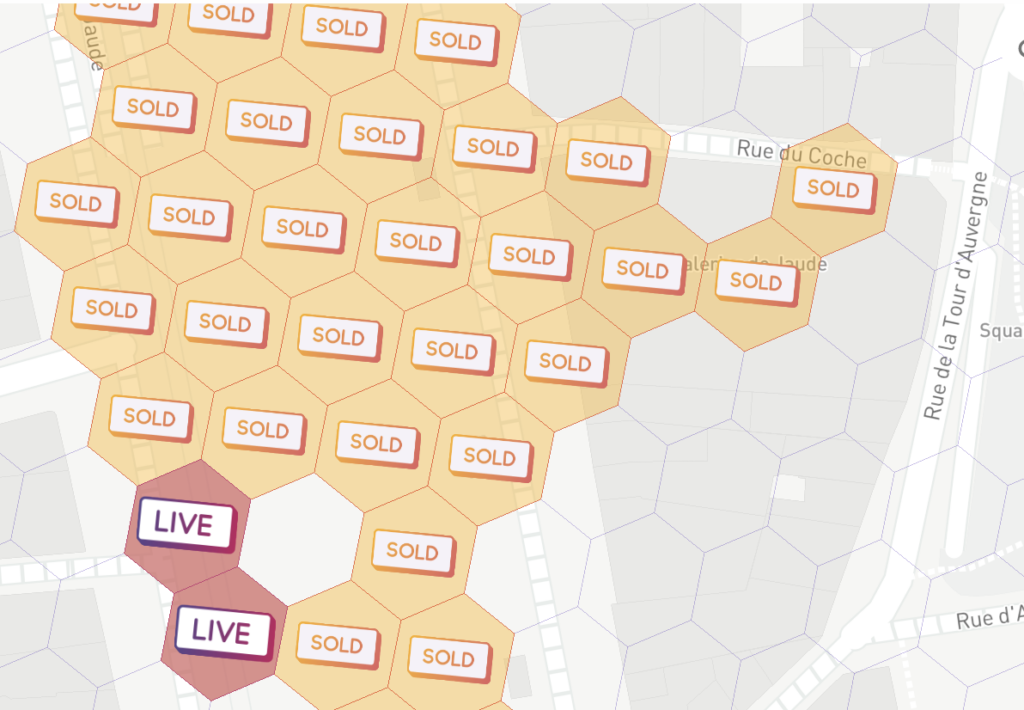
But building an AR experience is neither fast nor easy – especially for a solo software developer. This may partially explain why most users are buying and holding, but not often selling. Another possible explanation is that AR feels closer to being realized than VR, which is what most VRE collections have pitched themselves as eventually supporting. In this way, the payoff of holding OVR land may seem to users like it will come sooner than holding land from other projects.
What external factors will determine the long-term value of virtual real estate?
Because the metaverse is such a nascent space, the long-term value of blockchain-based VRE depends on a number of external factors. While most of these factors are hard to foresee, we believe that a couple of them may be:
- Whether AR/VR systems are more interoperable or proprietary
- The pace of adoption of new computing technology
Interoperable vs. proprietary technology
It’s easy to imagine a world where the R&D budgets of companies like Meta (current developer of the Oculus Rift) and Niantic (creator of Pokemon Go, the augmented reality hit) give way to a massive technological lead. The question, then, is whether the fruits of this labor will be broadly shared. In other words: to what extent will these companies’ technologies be open-sourced and accessible to build upon? And will they allow other metaverse companies to connect their projects, or will they create a walled garden within which only they can develop?
Meta had this to say about the subject in May:
The metaverse will be an interconnected system that transcends national borders, so there will need to be a web of public and private standards, norms and rules for it to operate across jurisdictions. There won’t be a Meta-run metaverse, just as there isn’t a ‘Microsoft internet’ or ‘Google internet’ today.
And in June, big-name tech companies like Microsoft, Meta, and Epic Games formed the Metaverse Standards Forum (MSF). This group is meant to create open standards for all things metaverse, including AR, VR, and 3D technology. Other big names include Nvidia, Unity, Sony, and the World Wide Web Consortium (W3).
It remains to be seen whether these companies will build out their metaverse(s) in a fashion that is interoperable with current metaverse projects and blockchain technology. However, there is at least one early indication of a more blockchain-compatible future: Epic Games’ acceptance of crypto games in its game store. While this has limited import to metaverse projects today, it’s extremely important to blockchain gaming – an industry with very similar commitments and aims. We cover these in more detail below.
The pace of adoption of new computing technologies
Assuming some degree of interoperability, blockchain-based metaverse projects stand to benefit immensely from the adoption of VR technology. The more immersive and life-like the virtual experience, the more likely it is for NFT-based ownership to feel tangible to users. So the faster VR technology grows, the better it is likely to be for metaverse land offerings.
Fortunately, the revenue generated from VR-based gaming is growing rapidly. From 2017 to 2021, VR gaming revenue had a compound annual growth rate of 28.5%.
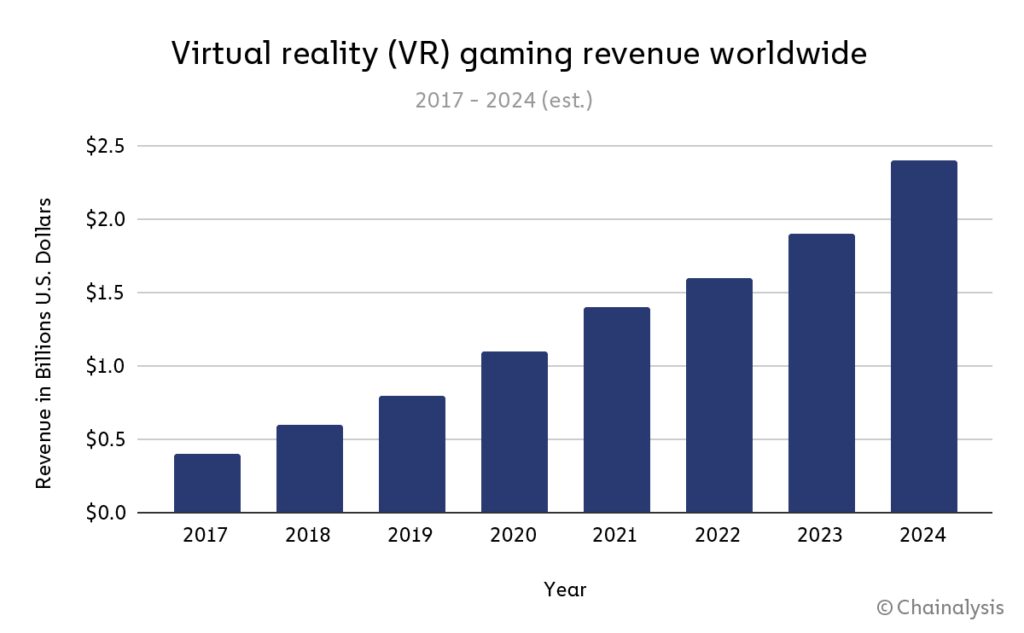
Also, analysts suspect that the VR boom will get only bigger – thanks in part to blockchain technology. Citi estimated in a March 2022 report that by 2030, the metaverse economy could be an 8 to 13 trillion dollar total addressable market. In its report, Citi listed VR and blockchain technology as two of the five key metaverse building blocks:
- Operating systems connecting people and content
- Blockchains that decentralize economic systems and digital asset ownership
- Natural user interfaces e.g., voice control and gestures for greater user immersion
- Extended reality (XR) headsets
- Cloud networking infrastructure.
Discussion
It’s worth noting that in this model, primary sales would still be EA’s main revenue driver. But the secondary sales, while accounting for only a fraction of EA’s $1.87 billion in revenue, would benefit players immensely. Even if we relax the assumption that the NFTs hold their original value, players of Ultimate Team could still walk away with hundreds of millions in earnings collectively – a far cry from the $0 they earn as “good citizens” today.
Furthermore, because in this model players recognize that they have a chance to resell their cards for a profit, it may attract an even higher annual player spend than our original $65 assumption.
The metaverse is fast approaching
All trends point to the metaverse. Virtual real estate now offers real-world utility; VR technologies are coming closer to reality; and blockchains are imbuing digital ownership with meaning.
We’re thrilled to be working with companies at the intersection of these three trends to build trust into blockchains, games, and the metaverse. When these trends finally collide, it will be a fascinating time to be extremely online.
This blog is a preview of our State of Web3 Report. Sign up here to download your copy!
This website contains links to third-party sites that are not under the control of Chainalysis, Inc. or its affiliates (collectively “Chainalysis”). Access to such information does not imply association with, endorsement of, approval of, or recommendation by Chainalysis of the site or its operators, and Chainalysis is not responsible for the products, services, or other content hosted therein.
This material is for informational purposes only, and is not intended to provide legal, tax, financial, or investment advice. Recipients should consult their own advisors before making these types of decisions. Chainalysis has no responsibility or liability for any decision made or any other acts or omissions in connection with Recipient’s use of this material.
